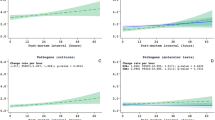Abstract
Post-mortem microbiology (PMM) is an important tool in forensic pathology, assisting to determine the cause and manner of death. However, there is a lack of standardisation of PMM sampling. In order to get a better insight into the methods used, the available technical options and developmental needs, ESCMID Study Group for Forensic and Postmortem Microbiology (ESGFOR) members designed a survey aimed at pathologists regarding common practices of PMM in clinical and forensic autopsies. Multiple choice questions were developed based on Cumulative Techniques and Procedures in Clinical Microbiology (Cumitech). The questionnaire was sent to pathologists mainly across Europe and Turkey using SurveyMonkey. The survey had 147 respondents. Although all pathologists were aware of the existence of PMM, 39% (19/49) of the participants were not using it. The three main indications for PMM were: (i) clinical suspicion of an infection not confirmed antemortem (83%), (ii) infectious signs at autopsy (83%) and (iii) as part of a standard protocol for foetal/perinatal or paediatric death (67%). Almost 80% of the participants using PMM stated taking 1–10 samples per case. Of the requested examinations, a general bacteriological culture (96%) and a specific polymerase chain reaction (PCR) assay for a particular infectious agent (34%) were most popular. The most frequent samples were: heart blood (66%), peripheral femoral blood (49%), spleen (64%) and lung (56%). Eighty-nine percent of the participants considered PMM a useful resource when investigating the cause of death. Although there are some common uses, this survey indicates that there is a need for improvement towards standardising sampling procedures in PMM.


Similar content being viewed by others
References
Caplan MJ, Koontz FP (2001) Cumitech 35, postmortem microbiology. Coordinating editor: BW McCurdy. ASM Press, Washington D.C.
Roberts FJ (1998) Procurement, interpretation, and value of postmortem cultures. Eur J Clin Microbiol Infect Dis 17:821–827
Nolte KB, Fischer M, Reagan S, Lynfield R; Members of the National Association of Medical Examiners (NAME) Ad Hoc Committee for Bioterrorism and Infectious Diseases (2010) Guidelines to implement medical examiner/coroner-based surveillance for fatal infectious diseases and bioterrorism (“Med-X”). Am J Forensic Med Pathol 31:308–312
Prtak L, Al-Adnani M, Fenton P, Kudesia G, Cohen MC (2010) Contribution of bacteriology and virology in sudden unexpected death in infancy. Arch Dis Child 95:371–376
Fernández-Rodríguez A, Alberola J, Cohen MC (2013) Análisis microbiológico post mórtem. Enferm Infecc Microbiol Clin 31:685–691
Rambaud C, Roux AL, Saegeman V (2012) Microbiological examination of post-mortem samples. In: ESCMID-SFM Manual of microbiology, 1st edn, pp 255–261
Morris JA, Harrison LM, Partridge SM (2007) Practical and theoretical aspects of postmortem bacteriology. Curr Diagn Pathol 13:65–74
Fernández-Rodríguez A, Cohen MC, Lucena J, Van de Voorde W, Angelini A, Ziyade N, Saegeman V (2015) How to optimise the yield of forensic and clinical post-mortem microbiology with an adequate sampling: a proposal for standardisation. Eur J Clin Microbiol Infect Dis 34(5):1045–1057. doi:10.1007/s10096-015-2317-x
Weber MA, Ashworth MT, Risdon RA, Hartley JC, Malone M, Sebire NJ (2008) The role of post-mortem investigations in determining the cause of sudden unexpected death in infancy. Arch Dis Child 93:1048–1053
Morentin B, Suárez-Mier MP, Aguilera B, Arrieta J, Audicana C, Fernández-Rodríguez A (2012) Clinicopathological features of sudden unexpected infectious death: population-based study in children and young adults. Forensic Sci Int 220:80–84
Acknowledgements
We are very grateful to all the forensic and clinical pathologists who participated in the survey. This survey was presented as an ePoster at the 26th European Congress of Clinical Microbiology and Infectious Diseases (ECCMID), Amsterdam, the Netherlands, 9–12 April 2016 (EV-0611).
Author information
Authors and Affiliations
Consortia
Corresponding author
Ethics declarations
Funding
There was no funding received for this survey or for the writing of the manuscript.
Conflict of interest
The authors have no conflict of interest to report.
Ethical approval
Ethical approval was not required for this survey, no patient data have been used. Accordingly, no informed consent forms were used.
Additional information
ESCMID Study Group for Forensic and Postmortem Microbiology (ESGFOR) members: Wafa Achour, Laurent Andréoletti, Ana Arribi, Alda Bazaj, Neval Elgormüs, Inés González, Aysel Karatas, Fernando Lázaro Perona, Stephen L. Leib, Miguel J. Martinez-Yoldi, Irene Merino, Catherine Moore, Jacob Moran-Gilad, Mario Poljak, Katja Seme, An Tamsin, Wouter Van Den Bogaert, Gülhan Yagmur, Ovidiu Mircea Zlatian.
Electronic supplementary material
Below is the link to the electronic supplementary material.
ESM 1
(DOCX 786 kb)
Rights and permissions
About this article
Cite this article
Saegeman, V., Cohen, M.C., Alberola, J. et al. How is post-mortem microbiology appraised by pathologists? Results from a practice survey conducted by ESGFOR. Eur J Clin Microbiol Infect Dis 36, 1381–1385 (2017). https://doi.org/10.1007/s10096-017-2943-6
Received:
Accepted:
Published:
Issue Date:
DOI: https://doi.org/10.1007/s10096-017-2943-6



